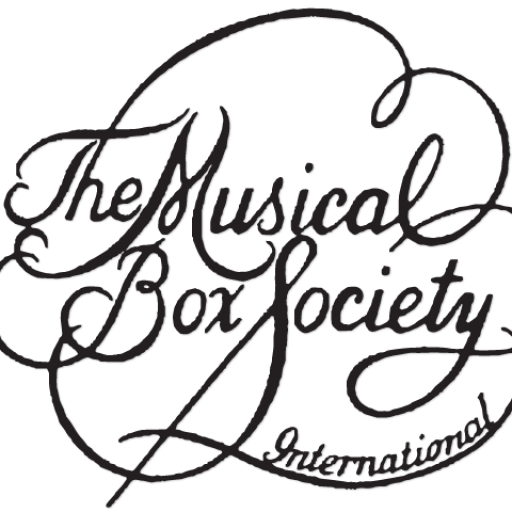The explanation of the terms listed below refer to their usage in the field of Mechanical Music. Many of the descriptions are from the book The Golden Age of Automatic Musical Instruments by MBSI member Arthur A. Reblitz, published by the Mechanical Music Press, Woodsville, New Hampshire; copyright 2001. They are used here with permission of the author and publisher. Permission is granted for writers to use a limited number of brief excerpts provided credit is given to the MBSI web site, the title of the original work and the author. Written permission is required for all other uses. German nouns and words that are also names of places are capitalized.
Edge Drive
The type of drive used to power musical box discs. In the gear type the toothed edge of the metal disc meshes with a toothed drive gear. In the sprocket type a toothed or knobbed sprocket wheel mounted under the disc near its outer rim engages with corresponding slots or holes in the outer edge of the disc.
Electric Lighting Effects
See lighting effects.
Electric Piano
1. Any electrically-operated piano (as opposed to a foot-pumped or hand-cranked piano). 2. Coin-operated piano, or coin piano. Term widely used by coin piano makers during the early 20th century. * Synonym: nickelodeon (modern usage; See nickelodeon). 3. A hand-played piano with electronic amplification of the tone-producing mechanism. Term used from the 1940s through the 1980s, when this type of electric piano was replaced by electronically-synthesized piano.
End Tab
At triangular tab at the very beginning of a music roll, usually made of glue-backed cloth, to which an eyelet or hook is affixed for attaching the roll to the take-up spool.
Endcaps
The brass plates which seal the cement in the brass cylinder of a musical box adding rigidity to the cylinder and providing the precise bearing surfaces which support the cylinder on the arbor and allow it to slide as the tunes are changed.
Endless Roll
Roll type made by gluing the beginning and end of a roll together to form a continuous loop. As the roll passes over the tracker bar it is fed into a storage bin. Advantages: 1. The roll passes over the tracker bar at a constant speed, so no tempo compensation is needed from one part of the same roll to another part. 2. The mechanism is simpler as no rewind/play mechanisms are needed. 3. The music is continuous, with no silent pause for rewinding. Disadvantages: 1. Rolls take several minutes or more to change. 2. Rolls are easily damaged during the changing process. 3. A large amount of space is needed for the roll storage bin in the piano. 4. It is impossible to select tunes by a fast forward or reverse mechanism. Endless rolls were mainly popular during the 1900-1910 decade, although some manufacturers (such as Link and the North Tonawanda Musical Instrument Works) used them in later years. Contrast with: rewind roll.
Endless Screw
Part of the governor assembly in a clockwork mechanism. It is the worm or helicoidally (spirally) - cut shaft to which the airbrake is attached. The airbrake fan at the top regulates the speed of the mechanism.
Endshake
The tolerance allowed in the endless screw of the governor that allows for a properly operating airbrake. Can be applied to any shaft that employs pivots held between planes.
Endstone
The jewel, usually a ruby or garnet, upon which the pivot of the worm or endless screw bears. It is held atop the cock bracket by the endstone cap.
Endstone Cap
The removable brass piece atop the governor cock bracket which holds the endstone in place.
Equalizer
See regulator, reservoir.
Escape Gear
See second wheel.
Escapement
1. A mechanism usually incorporating a series of gears, which regulates the use of mechanical energy, as in the escapement in a weight-driven orchestrion, which regulates the running of the motor. An escapement usually includes a governor, also listed in this Glossary. 2. In a piano action, the mechanism which releases the hammer just before it hits the strings, allowing it to fall back. This prevents the hammer from blocking against the strings and dampening out the tone.
Escutcheon
A decorative metal piece, usually adorning a keyhole or handle.
Expression
The varying of the volume or intensity of music. This is done by operating the controls of an instrument (e.g., the pedals of a piano), by opening and closing swell or crescendo shutters, by varying the suction level in a piano (low suction = soft music; high suction = louder music), by having pins of different length in a cylinder-operated instrument and by other means. An instrument is said to have "expression" if the musical performance can be varied in one of these ways. A music roll or music book may have expression cut in it to operate such controls automatically, or they may be operated by hand (as with the expression shutter of an organette).
Expression Piano
An automatic piano, usually electrically-operated, which has the pedals automatically controlled and which has limited suction-level variations. Examples include the Hupfeld Phonoliszt, the Recordo, and the Seeburg Style X. Many expression pianos have separate automatic controls for bass and treble hammer rails.
